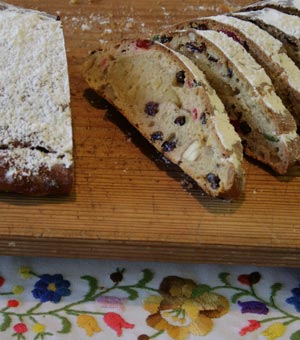
- Switch to Metric
- Switch to Imperial
Ingredients
For the Dough
- 4½ tsp dried yeast
- 55 ml warm water
- 170 ml milk
- 50 g sugar
- 100 g butter
- ½ tsp salt
- 500 g flour
- 1 egg
- 70 g raisins
- 35 g currants
- 75 g almonds, whole
- 10-12 glacé cherries*
- 35 g mixed peel
- 1 tsp cardamom
- 1 egg extra
- * red and green
For the Almond Paste
- 115g ground almonds
- 55g caster sugar
- 55g icing sugar
- 1 egg, beaten
- 2 drops almond essence
- 1 tsp orange flower water*
- * optional
For the Dough
- 1½ tbsp dried yeast
- ¼ cup warm water
- ¾ cup milk
- ¼ cup sugar
- 100 g butter
- ½ tsp salt
- 4 cups flour
- 1 egg
- ½ cup raisins
- ¼ cup currants
- ½ cup almonds, whole
- 10-12 glacé cherries*
- ¼ cup mixed peel
- 1 tsp cardamom
- 1 egg extra
- * red and green
For the Almond Paste
- 4 oz ground almonds
- 2 oz caster sugar
- 2 oz icing sugar
- 1 egg, beaten
- 2 drops almond essence
- 1 tsp orange flower water*
- * optional
Stollen
European festive breads are not difficult to bake, look very good on the table and are less demanding on strained digestions than rich cakes. Stollen are made from a light and fruity bread dough folded around a roll of almond paste, and are said to represent the infant Jesus in his swaddling clothes. They are always made in pairs, one for home and one to give away. There are many recipes for them but I always return to this one, which I cut out of the newspaper and stuck in a scrapbook around 1975. It came from Elisabeth Pederson, and I've kept to her version, except for the addition of ground cardamom which I particularly like. Stollen keep very well and thick slices are particularly good toasted, buttered and eaten with morning coffee as Christmas recedes into pleasant memory.
Getting Ready
- Make the almond paste by combining the dry ingredients and adding the flavourings and enough of the egg to make a smooth paste. Knead well and wrap in waxed paper. Line a large baking tray with baking paper. Cut the cherries in half and roughly chop the almonds. Whisk the extra egg until it is just liquid - you will use it for glazing.
Mixing
- Sprinkle the yeast on the warm water in a small bowl and leave for a few minutes to swell.
- Stir the milk with the sugar, butter and salt in a small saucepan over a gentle heat until the butter melts.
- Put 100 g of the flour into a medium-sized mixing bowl and pour on the hot milk and the yeast.
- Stir with a spoon and then a whisk until the mixture is smooth.
- Cover with a plate and set aside for about 20 minutes until it looks spongy.
- Combine the remaining flour, the cardamom and all the fruit and nuts in a large bowl.
- Pour the spongy mixture and the egg, which you have beaten lightly with a fork, onto the flour and fruit and mix it all together to a sticky dough.
- If you have a mixer with a dough hook, beat it for about 3 minutes, otherwise turn it out onto a floured board and knead it lightly until smooth.
- Put the dough into a greased bowl, cover with a damp cloth and leave until doubled in bulk - about 45 minutes.
Shaping and Baking
- While the dough is rising, roll the almond paste into two cylinders, each about 9 in/23 cm long and preheat the oven to 425 °F/220 °C. Turn the dough out of the bowl, knead lightly again, cut it in half and flatten each half into a rough oval using your fingers - they should be about ½ in/1 cm thick
- Lay the almond paste lengthwise in the centre of the dough, brush the edges with the extra beaten egg and fold the dough over to enclose it, making sure that the top edge does not quite cover the lower half. Pinch the ends together firmly
- Transfer the loaves to the prepared baking tray, cover with a cloth and leave to rest for about 10–20 minutes. They will not expand very much.
- Brush them thoroughly with the extra egg, and put in the hot oven to bake for 15 minutes, before lowering the temperature to 375 °F/190 °C for a further 30 minutes. Rotate at the same time. Cover the loaves with aluminium foil if they seem to be browning too quickly. When they seem to be cooked, turn one over gently using a spatula and tap the bottom of the loaf, which should be golden brown and sound hollow.
- Put your beautiful, fragrant Stollen on a wire rack to cool and dredge them in sifted icing sugar while they are still hot. Serve in thick or thin slices, buttered or not as you wish, and remember to give the second one away to a fortunate friend.